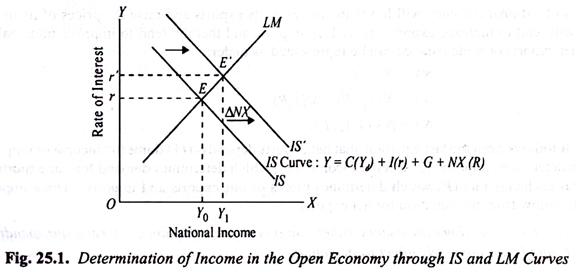Let us make in-depth study of the determination of income in open economy through IS and LM curves
IS – LM curve model involves the determination of national income and rate of interest through joint equilibrium of goods market and money market.
Since in an open economy a part of increase in income is spent on imports rather than on domestically produced goods, IS curve of an open economy is steeper than that of a closed economy. This means that for a given reduction in interest rate, a smaller increase in output and income is required to restore equilibrium in the goods market.
Besides, IS curve of the open economy also includes net exports (NX) as a component of aggregate demand for goods. The real exchange rate of the national currency, which determines the prices of exports and imports and thereby determine net exports also affects the open economy IS curve.
ADVERTISEMENTS:
For example, depreciation of real exchange rate of the national currency which raise exports and lowers imports results in increase in net exports and will therefore cause an outward shift in the IS curve to the right. Similarly, increase in foreign income which will raise foreign spending on our goods will lead to the increase in net exports, which is a component of aggregate demand, will also cause a shift in the IS curve to the right.
LM curve which represents money market equilibrium at various rates of interest and level of income is represented by the following equation:
M/P = L(r, Y)
where M/P stands for supply of real money balances, and L(r, Y) for demand for money which is determined by rate of interest (r) and level of income (Y).
ADVERTISEMENTS:
The intersection of open-economy IS and LM curves determine jointly the income and rate of interest in the open economy. This is shown in Figure 25.1. It will be seen that open economy IS and LM curves interest at joint E and determine Y0 equilibrium level of income and r equilibrium rate of interest.
Impact of Increase in Net Exports (NX):
Since equilibrium level of income in the open economy depends on foreign income (Yf) and real exchange rate (R), changes in foreign income or real exchange rate will affect equilibrium level of income. For example, if foreign income increases, it will raise the foreign spending on domestic goods or, in other words, it will increase our net exports.
The increase in net exports (NX) will cause a shift of IS curve to the right. This is shown in Figure 25.1 where as a result of increase in foreign income, say of the United States, which is our important trade partner. IS curve shifts from IS to IS’ With this it will be seen that equilibrium level of income has risen to Y1 and rate of interest to r’. It should be noted that increase in income also implies increase in output and employment.
ADVERTISEMENTS:
On the other hand, if there is recession in foreign economies, as was the case of American economy during 2001-03, it will reduce their imports and thereby reduce foreign demand for our exports. This will cause a leftward shift in the IS curve. As a result, our level of income and output will fall. Besides, rate of interest will also decline.
Effect of Depreciation in Exchange Rate:
Let us now see how depreciation in real exchange rate of the national currency, say Indian rupee, affects our national income. This can also be explained with the help of Figure 25.1. Depreciation in exchange rate encourages exports and discourages imports and thereby leads increase in net exports. Since net exports increases at each level of income, IS curve shifts to the right, say to IS’ in Figure 25.1. Thus, as a result of depreciation in real exchange rate, equilibrium level of income will increase.
Conclusion:
In the Table 25.1 given below, we summaries the effects of changes in domestic spending, foreign income and depreciation in real exchange rate on domestic income and net exports. It may be noted that + sign indicates increase and – sign indicates decrease.
It will be seen from this table that increase in domestic spending leads to increase in domestic income and to decrease in net exports. Increase in domestic spending leads to greater aggregate demand for goods and services and have therefore favourable effect on the level of domestic income.
Since a part of increase in domestic spending is made on imports of goods from abroad, it increases imports and, given the exports, will cause a decrease in net exports of the economy.
Increase in foreign income causes an increase in foreign demand for our goods (i.e. exports) which are a component of aggregate demand and has therefore a favourbale effect on the level of domestic income. Likewise, as increase in foreign income leads to more exports and, given the imports, will cause an increase in net exports.
Lastly, since depreciation in real exchange rate causes increase in exports and decrease in imports, it leads to increase in net exports. Increase in net exports raises aggregate demand for goods and has, therefore, a favourable effect on domestic income.

